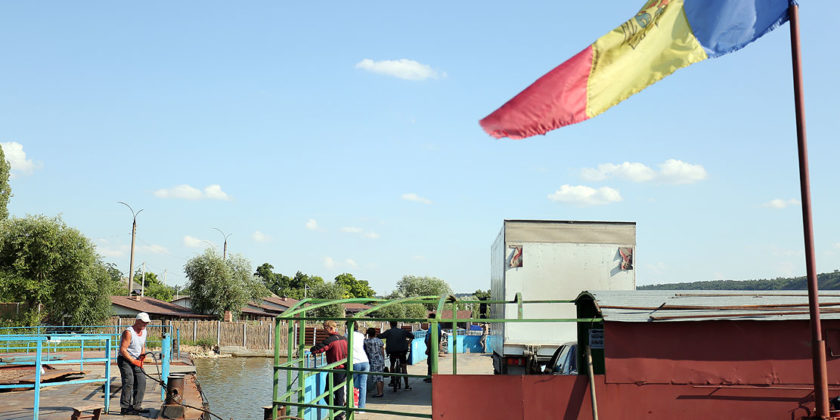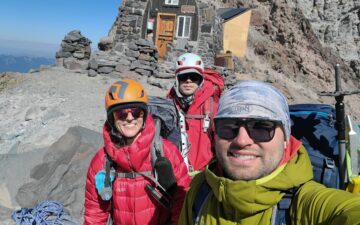The Molovata Ferry: A Bridge Uniting Two Moldovas

The Molovata ferry acts as floating bridge uniting the village of Molovata on the right bank of the Nistru River with the village of Molovata Noua on the left bank. One of the ways to cross the Nistru while avoiding the so-called customs posts under the control of Transnistrian military forces is using the floating bridge. The two villages are not so far apart, yet they exist in two different worlds. In Molovata, people have access to free media, locally broadcasted content. Meanwhile, in Molovata Noua, people rely on foreign or politically controlled TV programs, which broadcast content that has little to do with the reality of what is going on in the Republic of Moldova.
From the “informed” to the “uninformed” Moldova
The barge leaves Molovata village on the right bank of the Nistru River at even hours of the day. Passage is free for both people and cars. At ten a.m. two rows of cars are waiting to board on to the ferryboat. Some of the people are wondering if there will be enough room for all of them, or if some will have to wait another two hours. A Moldovan policeman is standing nearby writing in a register. Sometimes he speaks with those who are waiting to cross the river.

Suddenly, access to the ferry boat is allowed and a man dressed in a striped sailors’ shirt starts pointing drivers where to park their cars. The sailor, Leonid, has been working here for almost ten years. His job is to fit as many vehicles as possible on to the passage boat. Leonid signals to the drivers to be careful about passing along the track and directs them to place their cars in order to fill the small space to maximum capacity.
“Davai, davai!” he urges them forward, saying “come on” in Russian. “Steer the wheel! Now, go ahead.”
Twenty-two cars are boarded and parked side by side as tightly as possible, just like the sailor directed. Now the bridge is filled with cars – ranging from Soviet era cars to the latest European brands.

“I think there’s room for one more,” Leonid says. “Isn’t the post office car here? There’s still six minutes left,” he says, looking at his watch.
Mulțumim că citești ZdG!
Ajută-ne să continuăm să furnizăm informații esențiale — donează pentru jurnalismul nostru.
A few pedestrians have boarded the ferry boat too. The towboat that moves the ferry turns the engine on. The post office car didn’t show up for this crossing. The ferry leaves the shore to the sound of songs from the radio station Chanson.
Some drivers get out of their cars and look at the scenery. Three canoes with agile rowers seem to be preparing for a competition. Others are talking about the ecological status of the Nistru River. A father is explaining to his daughter the construction of the towboat’s engine.

Eugenia Demianova is among the people sitting in the pedestrian area. She travels to Molovata to look after her sister’s house. She has taken care of the house ever since her sister passed away and the children left for other countries. “A while ago, when there was no ‘bazaar’ (market, ed.note) in the village, there were lots of people. Now they bring everything to us in the village and it’s very good,” she said.
At the helm is Fiodor Nicolaevici, the captain’s aide. He keeps a close watch on the other bank of the river. The watercraft is made of two parts, he explains: The ferryboat on which the cars are loaded, and the towboat, which makes it move. The ferryboat will not move if it is not attached to the engine. Fiodor Nicolaevici tells us that his entire life has been linked to the Nistru River. He was born in a village on the riverbank, and he’s been working here since 1989, when this passage point belonged to the port of Ribnita. In his 60 years he has spent 10 years at the wheel of the towboat, moving the ferry across the Nistru.

The sailor told us that sometimes the river dies. A while ago it was navigable and the water at the shore was no less than two and a half meters. Now the water is muddy and sometimes reaches a minimum of 70 centimeters. The ferry cannot function in such conditions. If the water level is higher, he added, it’s easier to work.
The ferry is a great responsibility for the helmsman. He claims that they have used it since the Soviet period. And despite having procured part of its equipment later, it still cannot meet the needs of the crossing point. He told us that the ferry depends on the power and direction of the wind. He confessed to us that he has managed to develop an instinct and dexterity for steering the wheel of the ferryboat.
The helmsman complains that young specialists do not come to work here because the salary is small. He claims that if they would offer a good salary that can keep pace with current prices and expenses, then the young ones would be tempted to come and learn. He points out that even a young specialist would have to be taught everything from scratch, because there is no school in Moldova where they can gain theoretical knowledge. The captain’s helper steers the wheel of the watercraft and concludes that Moldova lacks both a fleet and specialists.

After 15 minutes, the ferryboat arrives on the other side of the Nistru River. The car engines start, and, with the same cries “go ahead” and “davai, davai,” Leonid the sailor directs the traffic towards the exit.
In a Moldova thirsty for news
Although geographically Cocieri and Molovata Noua villages are situated on the left bank of the Nistru River – a region on Moldova’s eastern border that, as a result of a conflict frozen since 1992, is part of the unrecognized territory Transnistria. Nevertheless, these villages are technically subordinate to the Government in Chişinău. Here people divide time in two parts: before the 1992 conflict on the Nistru River (known as the Transnistria War) and after it. They speak carefully and can easily recognize people who are not from their village, and ask the reason for their visit in the village.
“Is it true that Plahotniuc ran away? “
Aunt Nina is one of the few villagers we met on the streets of Cocieri. Realizing that we are guests and that we probably know more than she does, she asks with the curiosity of a child: “Is it true that Plahotniuc ran away?”
There are no services in the villages of Cocieri and Molovata Noua that provide fiber optic cable television, which could transmit the content of independent television stations from Moldova. Raisa Spinovschi, the mayor of Cocieri, reports that the village inhabitants use several types of antennas to get access to television stations: simple antennas, parabolic antennas or the Transnistrian cable television “Sheriff.”
Nina Ursu, director of the Struguraş Sanatorium in this village, says that the beneficiaries of the sanatorium see a big problem in the lack of independent television stations. The institution cannot provide its clients with either internet or high quality telephone service. She has repeatedly made requests to telephone, Internet and television service providers, but nobody has responded. She thinks that connecting to the fiber optic network would solve the problem, but she doesn’t understand why it hasn’t been done yet.

Maria Boldu is retired and lives in Chişinău. She came to the Struguras Sanatorium from Cocieri for rehabilitation. She arrived at the sanatorium in June, when the new government was established and changes began to take place in all state institutions. But now, being at the sanatorium, Maria says she has no access to information from the television stations she’s used to watching at home.
“I don’t like it here because we are misinformed. I do not know why we have no access to Jurnal TV, TV8, ProTV, these ones are missing here. Apparently, we are in Moldova, but I do not understand why they are not available here,” she says.
Violeta Druta, another beneficiary of the Cocieri sanatorium, is a high school teacher from Chişinău. She encountered huge problems in 2018 when trying to receive some documents by mail. Because of the lack of Internet there, she was forced to return to Chişinău to get the papers.
The Mayor of Cocieri, Raisa Spinovschi, says there was not a single complaint from the locals regarding the lack of access to television. “When there’s no demand, there’s no need to offer,” says the mayor. She confirmed that even with a parabolic antenna at home, she sometimes fails to get independent TV stations of Moldova, and has to call a specialist to adjust the antenna. The mayor also added that, last year, there was a company interested in installing cable television in the region. The mayor’s office was in communication with him, but then he disappeared.
The mayor says that if a company wants to provide cable television services, the village hall would need first to carry out a survey among the population to analyze the cost of the service and its potential benefits.
Media expert Ion Bunduchi believes that in the Republic of Moldova there was a period when the authorities on the right bank of the Nistru River did not want to “upset” those on the left bank. What’s more,low coverage by independent television stations is a serious concern in other regions of the Republic of Moldova.
“During the electoral period, one third of the constituencies had no radio, television or newspapers from which to get information,” the expert said.
If there had been any requests made to the state enterprise Radiocomunicatii, some low frequency TV could have been installed to allow these villages to access information from independent television stations. The Republic of Moldova is trying to move from analog television to digital television, however, this hasn’t worked yet because it is too expensive. Ion Bunduchi adds that this problem could be solved if there was a company to provide cable television services in the region that would include independent television stations in the grid. This way, residents from Cocieri and Molovata Noua would have access to information, including from these TV stations.

Radiocomunicatii, which regulates broadcasting on the territory of the Republic of Moldova, claims that the institution ensures the broadcasting of the stations that were issued a license by the Audiovisual Council. Distribution of these posts is done through three national networks, which are under the company’s management. According to Radiocomunicatii, the villages of Cocieri and Molovata have access to the state television Moldova 1, TV3, Radio Moldova 1 and the radio station 100.5 MHz through an analogue channel. Allegedly, the inhabitants of these localities can also watch the stations Moldova 1, TVR 1, Channel 2, Channel 3, Prime and Publika TV in digital format.
That being said, a 2017 study conducted by the Independent Press Association revealed that Channel 2, Channel 3, Prime and Publika TV all belonged to former Democratic Party (PDM) leader Vladimir Plahotniuc, and that they broadcast content that contains manipulative messages in favor of the PDM)
The ACUM Bloc has also criticized the national television Moldova 1 for avoiding broadcasting important events in the country, and for not giving airtime to members of the ACUM Bloc when their party was in the opposition.
Lia Guţu, Head of the General Directorate for Licensing, Authorization and Monitoring within the Audiovisual Council, declared that all television stations, including those requested by people are licensed. The problem is that the “authorities” on the left bank of the Nistru are jamming the signals, so the issue must be solved at another level. In this case, this would require government involvement and a dialogue with the so-called Transnistrian authorities.
According to the 2014 census, the villages of Cocieri and Molovata Noua are home to 5,882 people. The winter is the most difficult time for these villages, because the ferryboat does not cross the river, and the so-called Transnistrian administration restricts their access to agricultural land.
Corina Șeremet



